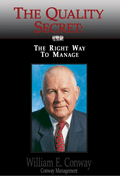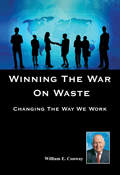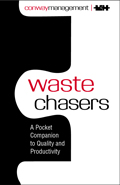Volume 27, No. 1
|
In This Issue
recent posts:
recent posts:
— Confirmation Bias:
"Trust changes everything."
— Stephen M. R. Covey
Trust enables great people to do great things"
— Aron Ain
"The faster you see things as they really are, the faster you can get to work on improving them."
— Aron Ain
"In God we trust. All others bring data."
— W. Edwards Deming
The Quality Secret  Kindle Edition available @ Winning the War on Waste  Kindle Edition available @ Waste Chasers  Time-Finder — Work Sampling Kit  Visit conwaymgmt.com for more CI Tools |
by Sheila Julien, Senior Associate
You might call it a “secret weapon” but, to be honest, it is the exact opposite. Because unlike a weapon, it is constructive rather than destructive; the only harm it could do a competitor is to leave them behind. And it is anything but secret. In his recent book, WorkInspired, How to Build an Organization Where Everyone Loves to Work, Aron Ain openly shares the pivotal role it has played in Kronos’s amazing growth story. Trust — the soft concept producing results that are hard to beat.
The role that trust plays in an organization’s success has been written about before by keen observers of human and organizational dynamics. Patrick Lencioni in The Five Disfunctions of a Team identifies the lack of trust among a management team as the root cause of most poor performance. Stephen M. R. Covey in The Speed of Trust: The One Thing That Changes Everything passionately echoes this view, citing research indicating high-trust organizations out-perform their low-trust competitors by 300%, because a lack of trust increases costs while simultaneously reducing an organization’s speed and agility.
What’s different about Ain, CEO of Kronos, a leading global provider of workforce management cloud solutions, is that he can tell us how trust is working in action today and about the tools and methods in place to support the practice and enhance the effectiveness of trust. At Kronos, everyone is expected to give trust both within and outside their functional areas and to practice behaviors that earn the trust of their employees, teammates, and managers. According to Ain, the culture of trust contributes to much more than high engagement and retention, as important as those are, but to amazing business results. And the results Kronos has achieved are great! Revenue has tripled; Kronos has surpassed 35,000 customers worldwide, innovations are rolling out faster than ever, and employee engagement scores are through the roof. Kronos once again occupies the #1 spot in the Boston Globe’s Top Places to Work list in Massachusetts. It received an award from Fortune Magazine for Best Workplace for Millennials - 2018. It is on both Glassdoor’s and Fortune Magazine’s lists of top 100 places to work and has received numerous other awards for workplace engagement. Why Trust Matters To many of us schooled in facts and data, trust may seem too soft a concept to produce a competitive edge. Not so. A high level of trust is essential to creating an agile, highly competitive organization and here are some reasons why.
No Trust — No Speed In a world where new challenges arise very quickly, it is the failure to act, failure to improve, and failure to innovate that poses the biggest risk to a company — not the risk of making a mistake. However, to an individual in a low-trust environment, by far the biggest risk is making a mistake. For these individuals, trying something new is much riskier than doing what’s been always been done. Innovation or even simple improvement is not going to happen. The whole organization slows down. Covey, in The Speed of Trust, puts it this way: “When trust is low … it places a hidden ‘tax’ on every communication, every interaction, every strategy, every decision.” People don’t fully hear what their leaders are saying, because they factor in guesses about the leader’s intentions. They wonder how transparent their leader is being. Employees don’t buy-in to decisions that they don’t trust. Ain points out that lack of trust places “a huge overhead burden on a relationship.” He insists that when you employ someone, you should go ahead and trust them! Will you get burned on occasion when trusting people? “Absolutely!” Ain says, “But almost always my trust in team members has proven well-founded. And the benefits are numerous.” By building a culture where employees know they are trusted and where they trust their managers and teammates, Kronos has created an organization where it is safe for people to be creative and to aim for the best possible outcomes, continuously getting better and better. No Trust — No “Exposing Reality” Exposing reality is a practice Kronos has consciously worked on for over a decade. Exposing reality means trying very hard to look at things the way they really are, rather than the way we wish they were. As Ain points out, “the faster you see things as they really are, the faster you can get to work on improving them.” But in a low-trust environment, people are especially motivated to gloss over uncomfortable truths and to declare victory and move on rather than checking to see if they did or didn’t get the results they expected. Trust enables us to admit what we don’t know, recognize and recover quickly from mistakes, and to put uncomfortable information, questions, and contrary opinions out in the open, where the team can work through them with honesty and passion to arrive together at the best strategies and decisions. No Trust — Poor Results In a low-trust environment, employees hold back information or ideas that seem risky to share, so leaders make decisions based on incomplete information and without knowing all the potential consequences. And when employees believe their managers are making decisions without all the relevant input and information, they often question or even slow-walk the decisions. Covey cites polls showing that only 45% of employees have trust and confidence in senior management. Lencioni, in The Five Dysfunctions of a Team, places lack of trust at the foundation of his pyramid of dysfunctions culminating in poor results. Without trust among a team, people keep their cards close to their chests. They are afraid to admit the limits of what they know, afraid to admit any vulnerabilities. Because they don’t trust one another, they fear conflict and withhold uncomfortable information and dissenting views. Without complete information, these teams make poor decisions, and the decisions they do make are poorly executed because they do not arrive at a shared commitment to the decision unless they have aired and resolved dissenting views. Thus, a lack of trust leads to both flawed strategies and poor execution. When these organizations fail, Lencioni says, the press may point to poor strategy or poor execution while the root cause is lack of trust among the team. Trust Inspires and Engages Covey observes that “trust is one of the most powerful forms of motivation and inspiration. People want to be trusted. They respond to trust. They thrive on trust.” This is exactly what Ain sees happening at Kronos. “Because we place so much faith in employees,” Ain explains in WorkInspired, “they return the favor, placing a remarkable degree of trust in us. Their trust in turn leads to far better performance — more innovation, quicker recovery from mistakes, more energy and enthusiasm at work.” While many factors contribute to Kronos’ financial and market achievements, Ain strongly believes that the culture of trust has been fundamental to the success Kronos has had in innovating, growing, and engaging. Is it Easy? No. Trust may seem like a “soft” concept, but it requires hard work.
“We’ve worked incredibly hard to instill trust throughout the organization, one manager at a time, starting with me,” Ain tells us. “First, we give employees atypical degrees of latitude and freedom. Until proven otherwise, we assume their competence, judgement, and good intentions.” Kronos also deploys tools that support the creation of a high-trust organization, such as Predictive Index, to help people get to know one another, and a performance feedback and rating system that gives substantial weight to an employees’ effectiveness at building trust. They also establish HR policies that demonstrate trust as an organizational philosophy, such as work-at-home options, and unlimited time off. In addition, the management at Kronos works very hard on three specific management behaviors that support effective deployment of trust: overcommunication, courage, and studying results. Overcommunication Trusting your people to just do what they think is best for the organization doesn’t work out nearly as well if internal communication is weak. Even the very best people putting forth their very best efforts will make many more wrong turns if they are in the dark about company strategy, priorities, and what other projects are underway that may impact their efforts. “I didn’t think they were going to do that!” one unhappy manager (at a different company) said to me. He had empowered a team to go solve a problem without effectively communicating with the team at the start — nor along the way — and the team came up with a plan that conflicted with another initiative they didn’t know about. The team lacked the information they needed to be successful, and the manager concluded empowerment doesn’t work — a lose/lose outcome! Communication is so important that Ain devotes the second chapter of his book to overcommunication. “Don’t just communicate,” he says, “overcommunicate. You really can’t do it enough!” And when Ain says overcommunicate, he means at every possible opportunity, in every direction, and throughout the company. He communicates to every employee through frequent emails and short videos. For example, every three or four weeks, Ain sets up an iPad and just shares with all the employees what’s on his mind and what’s going on in the company. Very informal, no script, just to make sure everyone knows what’s going on. He works hard at transparency, insisting “they can handle the truth!” — so he tells them the truth. Inquiry and listening are just as important forms of communication as updating and explaining. Ain takes every opportunity to chat with employees, as he walks through the hallways or rides the elevator, building relationships, asking everyone he meets open-ended questions to learn something about them, to ask their opinions, and to let them know he is interested in them. So, he comes across as very approachable. He also practices “micro-communications,” popping in on employees for two- or three-minute conversations, to get their input on an issue he’s working on. And when he visits a remote location, he takes the time to say hello to every single employee — even if it takes half a day such as when visiting employees in India. “Don’t I have more important things to do?” he asks, then answers his own question. “I really don’t. Our people matter most, and they want us to communicate more than they want just about anything else.” Ain also invests in facilitating great communication among his leadership team. In addition to weekly 1-1 meetings between Ain and his direct reports, his executive team gathers in his office every week for an hour or two, with no agenda other than to share what’s going on, ask each other for feedback, and make sure they are all in the know. And his leaders do the same with their teams to make sure there is effective communication throughout the company. In fact, one of the leadership behaviors explicitly expected of all Kronos managers is to build robust cross-functional internal networks. This frequent high-quality communication produces a high level of alignment and collaboration so the entire organization can execute with high confidence and high speed. Courage to Lead Lencioni says a leader must have the courage to be vulnerable and to tolerate and work through conflict. At Kronos, the concept of courage has an even higher profile. Kronos requires that managers learn to lead with genuine courage. Ain believes “being a good manager is really, really difficult. And the sooner people who are managers recognize that, the sooner they’ll start being a good manager.” (The New York Times, 2016-09-11) So Kronos has developed a management training program to teach the courageous methods and principles required to be an effective manager at Kronos. They call this program Courage to Lead, “and the action word isn’t ‘lead’,” emphasizes Ain, “The action word is ‘courage’.” Because it takes unbelievable courage to be a great manager. The Courage to Lead program has three major sections: Be Bold & Humble — Challenge & Support — Disrupt & Connect. And the first principle under Be Bold & Humble is: ‘Trust others, both within and outside your functional area.’ It takes courage to trust someone. It takes courage to admit when we’ve made a mistake or admit what we don’t know. It takes courage to expose reality. It takes courage to have honest and difficult conversations. If a leader lacks this courage, will the people who work for that leader trust him or her enough to admit their own mistakes? Or to admit when they don’t fully understand the strategy? Or to initiate an uncomfortable discussion? Of course not! A leader must model that courage before they can expect to receive trust. Ain puts it this way: “The best way to persuade people to trust you is not to lecture them about trust, but simply to trust them … modeling what you wish to cultivate in your team, department, or entire organization.” Studying Results But what if you trust in someone or something and it’s just not working? How will you know? Trust doesn’t mean assuming everything will all work out as planned. Far from it! While Ain doesn’t talk much about Deming’s Plan-Do-Study-Act cycle, he describes it in action: they plan carefully, try out an innovation or improvement, then study the results, and act on what they learn. “We measure everything,” Ain says. So, no matter how much Ain loves an idea, he doesn’t conclude it is a success until he sees the data. He says, “Go try it” and then measures and studies the data and only then will he know if it’s working the way they expected. This is their commitment to “exposing reality” — seeing how the plans and decisions are actually working without succumbing to wishful thinking. One example Ain describes is when he, himself, made a key hiring mistake. When making the hire, Ain believed he had found a great fit for the job — but he didn’t assume it was a great hire. He put in the effort to check whether his decision was correct. After a few weeks, Ain checked in with the people the new manager worked with and he heard it wasn’t going very well. This feedback enabled Ain to promptly provide the new manager with useful feedback so he could try to get things back on track. Ain checked back a few weeks later only to find out that, unfortunately, it wasn’t getting any better. He faced the reality that he had made a hiring mistake and they needed to part company. As painful as it was to admit such a mistake, the speed of exposing the reality and addressing it prevented much more pain later. Similarly, Kronos doesn’t assume everyone who goes through Courage to Lead training is good to go! As Ain puts it, “Not everyone who goes to Harvard comes out with the same knowledge and skills.” They needed to go find out how well it was working. To measure the results, Kronos developed a Manager Effectiveness Index (MEI), which surveys employees every six months to give managers timely information about how they are doing and what they need to work on. Kronos supplements this with training and coaching to help managers hone their skills. And from 2016 to 2017 the overall MEI score went from 81% to 87%. These tools are developed by their small in-house Talent Development Team reporting to HR. “HR are the real heroes of the outfit here in a lot of these areas,” Ain declares, “Certainly not about trust; we all own that. But certainly, around Courage to Lead training and manager effectiveness. They have the freedom to go be creative because they know I believe engaged workforces produce better outcomes.” A Culture of Trust Kronos has demonstrated that creating a high-trust culture is worth the investment — just as Covey predicted in The Speed of Trust. And speed is more important today than any time in our history, as change — the pace of change, the amount of change, and the disruptive nature of the change— takes place at an unprecedented rate. The coping strategy is to be able to change and disrupt even more quickly, through the speed of trust.
Thanks to a culture of trust — supported by great overcommunication, courage, by measuring results and exposing reality — the talents and creativity of the highly engaged workforce at Kronos have been set loose to accelerate improvements, solve challenging problems, innovate and disrupt to better meet customers’ needs and help Kronos thrive. Now that the secret is out, who wouldn’t want to copy that? Note: If you are reading a pass-along copy of this newsletter and would like to have your own copy, please use this link to start your own account. If you have any comments, questions, or suggestions or to inquire about any of our products and services, please email us at mj.king@conwaymgmt.com. We are always glad to hear from you. |
||
|
Copyright © 2019 Conway Management Company, Inc.
All Rights Reserved
|

